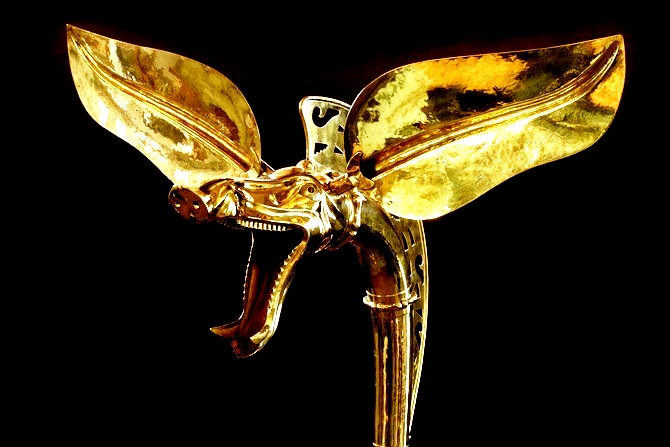UD: Jan. 2020
“For there were among them such innumerable horns and trumpets, which were being blown at the same time from all parts of their army, and their cries were so loud and piercing, that the noise seemed to come not from human voices and trumpets, but from the whole countryside at once”.
(Polybius, Histories, II, 29)
Iron Age Europe produced a wide variety of wonderful ceremonial and war trumpets, ranging from the clay trumpets of the Celtiberian sphere to lavishly decorated bronze examples from Ireland. As well as their functional nature, such trumpets also represent wonderful examples of Iron Age Celtic art.
Clay trumpets with geometric decoration from the Celtiberian city of Numantia (Soria), Spain
(2/1 c. BC)
Wolf-head amplifier (clay) from a war trumpet, discovered at Numantia (2-1 c. BC)


However, undoubtedly the most unique and distinct of “barbarian” musical instruments of this period is the Celtic carnyx – a type of elongated war trumpet which was usually (but not exclusively) shaped as a boar’s head. The term “carnyx” is derived from the Gaulish root, “carn-” or “cern-” meaning “antler” or “horn,” the same root as in the name of the Celtic god Cernunnos (Delmarre X. (2003) Dictionnaire de la langue gauloise. Paris. p. 106-107). The instruments themselves were of bronze and played upright, as illustrated by their depiction on the Gundestrup cauldron.
Carnyx from the Gaulish sanctuary of Tintignac (Corrèze, Gaul), and examples depicted on the Gundestrup Cauldron
Reconstruction of a Carnyx found at Tintignac. The carnyx was 1.80m. long, and one of 7 found at the site (6 representing a boars head, and one a serpent)
(after Gilbert J., Brasseur E., Dalmont J.P., Maniquet C. Acoustical Evaluation of the Carnyx of Tintignac. In: Proceedings of the acoustics conference, Nantes 2012. p. 3956-3959)
Besides depictions on coins and other artifacts from the period, archaeological evidence of the carnyx has been found at Celtic sites throughout Europe, stretching from the British Isles to the Balkans, illustrating that it was common to the pan-Celtic tribes across the continent.
Celtic carnyx depicted on a Roman gold stater from 48 BC
Serpent headed carnyx from Tintignac
Boar headed carnyx from Deskford (Banffshire) Scotland (1st c. AD), and reconstruction.
Fragment of a carnyx discovered in the Celtic settlement of Epomanduodurum (Mandeure) in eastern France (2/1 c. BC)

Wild boar terminal from a Celtic carnyx discovered at Corrèze in southwestern France (2/1 c. BC)
“Their trumpets again are of a peculiar barbarian kind; they blow into them and produce a harsh sound which suits the tumult of war”
(Diod. Sic. V,30)
Scientific reconstructions of these strange instruments, based on archaeological finds (Gilbert et al 2012), confirm that the carnyx produced a distinctive eerie sound, unlike any other ancient or modern musical instrument, and was therefore ideally suited to the atmosphere of battle, for which it was created.
Carnyx discovered in a ritual pit at the Gaulish sanctuary at Tintignac
How the Carnyx may have sounded:
Mac Congail
.












Do you think the Carnyx and the Dacian ‘Draco’ had much in common? I note the proximity of the snake and the carnyx players in the ‘warrior’ panel of the Gundestrup cauldron, and wondered if this might represent a ‘code’-expression of some link in their symbolism. Obviously, the Gundestrup ‘musicians’ do not have serpentine banners trailing from their instruments, but I wonder if there are carnyxes (carnices?) yet to be found with evidence of hybridisation with the ‘draco’ in Dacia/Thracia/Balkans?
To answer this question we should first ask who were the ‘Dacians’?
Perhaps the Romans disliked the use of the Carnyx among their auxiliaries and the Dacians transformed it to the ‘draco’ banner later on? I wonder if Dacian ‘Gebeleizis’ is anything to do with the Celtic/PIE word for ‘horse’?
Reblogged this on Die Goldene Landschaft.